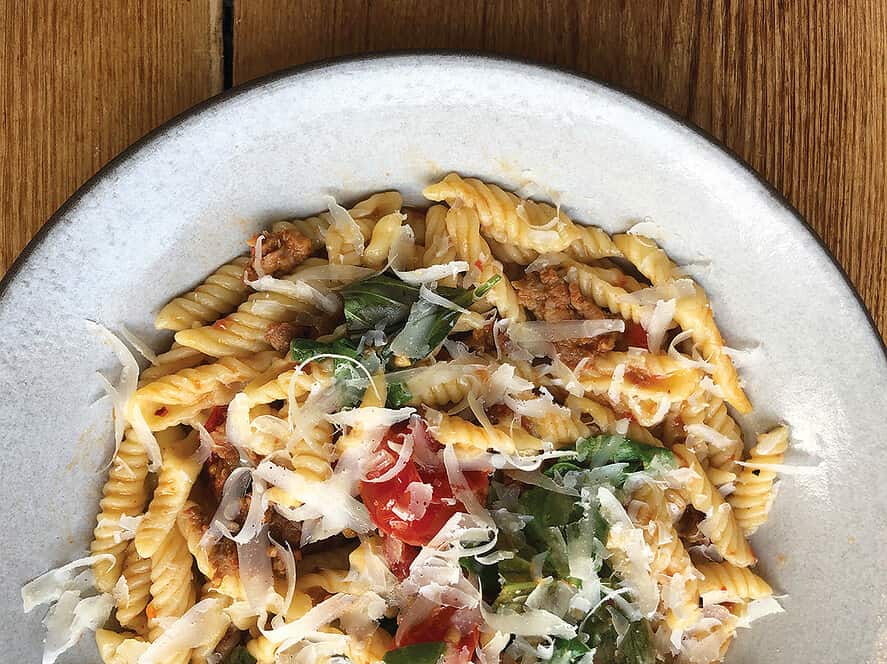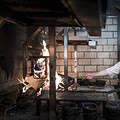Share this Post
I have long had a problem with what most of us consider “cooking.” It usually starts with a recipe, followed by a trip to the grocery store and then, after too much recipe reading and self-doubt, it ends with a dish that doesn’t look as good as what’s on Pinterest and a sink with an unnecessary number of soiled measuring cups.
With the exception of baking, which is more of an exact science, cooking at home doesn’t need to be so measured. Now more than ever, in this time of quarantine, cooking should be inspired by the ingredients you already have—not what you need to go out and buy.
Take, for instance, pasta, which I assume, based on the bare shelves at the grocery store, all of you have at home. If you have pasta on hand, you can chisel out a delicious and frugal meal from the contents of just about any kitchen.
Most published pasta recipes follow roughly the same procedure, so understanding pasta as a process rather than a specific recipe puts you in control of what goes in it. In my opinion, an excellent pasta entrée contains eight easy, customizable components.
8 Easy Components
1. Pasta
If you want to eat a substantial amount of meat and veggies with pasta, reach for something bite-sized such as rigatoni or bow-ties (if you’re feeling fancy), or something wide with a lot of surface area like pappardelle or tagliatelle.
The average serving of dry pasta per person is about one cup, depending on shape. To eyeball, consider that dry pasta almost doubles in volume when cooked.
2. Fat
Fat absorbs flavor and spreads it across the palate. As long as you don’t grossly overuse it, fat gives sauce a velvety texture and a glossy finish. I start with roughly one tablespoon of fat per serving and I’ll usually stir in a knob of butter into the finished dish.
Popular choices include olive oil, butter and my favorite—pork fat. If you have any cured pork—bacon, pancetta, salami—start your sauce by chopping it up and rendering the fat out over medium heat before sweating the aromatics.
3. Aromatics
Carrot, celery, onion, jalapeño, bell pepper, fennel, garlic—one or more of these, when sweated in the hot cooking fat until soft (about five minutes), will add a great depth of flavor to the finished sauce. Just be sure to chop them fine. If you’re using garlic, add it last so it doesn’t burn.
4. Protein
Unless it’s something like shrimp that cooks very quickly, your protein should be pre-cooked (leftovers work great) and chopped to about the same size as the noodles. If you’re using a long, wide noodle like pappardelle or tagliatelle, consider using ground or finely chopped meat for improved adhesion.
5. Vegetables
Just like the protein, your vegetables should be cut appropriately for the shape and size of the pasta and fully or almost fully cooked before adding them to the sauce. Frozen vegetables are usually pre-cooked, so they can go right in—no thawing required.
6. Liquid
The liquid you choose will constitute the bulk of your sauce, so this is a major flavor choice. I often choose more than one. Just remember—if you’re using something alcoholic like wine, add it first and reduce by half to ensure that the alcohol cooks out.
Some options: wine, beer, chicken stock, vegetable broth, milk, cream, tomato sauce and canned diced tomatoes.
7. Herbs
In my mind there are two categories of herbs: hard and soft.
Hard herbs—rosemary, thyme, sage and oregano—should be added to the dish early on to cook out their raw, piney flavor. Since they are so hearty, hard herbs are decent in their dry form, although I still prefer fresh whenever possible.
Soft herbs—the delicate, leafy ones like cilantro, parsley, basil, dill—are especially nice in pasta. They can be chopped and stirred into the sauce at the very end of cooking and/or sprinkled on as a garnish. Because they’re so delicate, I don’t like to use dried soft herbs.
I love to grow herbs in the warmer months (stay tuned for next month’s column), but when I don’t, I keep a stash rolled up in damp paper towels in the fridge.
While basil is the obvious choice for most pastas, penne with chorizo and Brussels sprouts in a dill cream sauce is nothing to turn up your nose at—so get creative.
8. Cheese
Pre-grated parmesan is fine, just don’t buy the shelf-stable stuff in the tube. If you want to know why, read the ingredients.
In my mind, cheese is mandatory. Stir it in at the very end to thicken the sauce and garnish with however much makes you happy. Pecorino is great in certain applications, but parmesan and grana padano (parmesan’s younger brother) are more versatile, so that’s what I keep around.
The Process of Pasta
First, choose your ingredients and have them all chopped up and ready to go. This fundamental virtue of preparedness is lovingly referred to as mise en place in professional kitchens, French for “everything in its place.”
Bring water up to a boil and add enough salt so you can taste it but not so much that it tastes like the ocean. Since dry pasta contains zero salt, it’s important to use this step as an opportunity to season the noodles. Add the pasta to the water and set a timer for 1-2 minutes less than the box recommends.
Heat the cooking fat in a medium-large skillet or sauté pan. Start gently sweating the aromatics with a pinch of salt over medium or medium-low heat until everything is soft (about 5-10 minutes). Be careful not to over-season at this point—you may be adding some salted pasta water to the dish later on.
Next, add garlic and hard herbs. If your sauce is going to be tomato based, this is a good time to add some tomato paste (which I find more convenient to buy in a tube instead of a can). Cook for another minute, until the garlic softens and your kitchen smells like Carmela Soprano’s.
Bump up the heat to medium-high and add protein and veggies to the pan. Cook, stirring regularly, until heated through.
Then—making sure wine and anything alcoholic are first—add your liquids. There should be enough liquid to fill the pan approximately a half inch deep. The noodles will absorb some of the sauce as they finish cooking, and there will be an opportunity for adjustments later.
When the pasta timer goes off, reserve a cup of pasta water and strain before adding the pasta to the sauce. Finish cooking the noodles in the sauce, adding back pasta water as necessary.
When the noodles are pleasantly al dente, stir in a knob of butter or a glug of extra virgin olive oil (a tablespoon or two per serving—feel free to eyeball it), 1-2 small handfuls of grated cheese and chopped soft herbs. Add salt if needed and crushed red chili pepper if desired. Top with more cheese and chopped soft herbs and serve.
In this series, local chef Bobby McFarland offers tips on how to cook like the pros. Currently the lead culinary consultant at The Kitchen Raleigh, McFarland loves eating pomegranate, cheese and all things pork. His culinary hero is Alton Brown.
Share this Post









Comments
That is my pasta dish at the top. I made that with my hands and took the photo
Hi,
I just discovered your website and read some blogs and I can’t stop myself from contacting you and giving you a big Thumbs Up for the quality work that you’ve been doing.
I am also writing about (healthy food) these days and I’ve written an article on the topics
I’ll be very honoured If you post my article on your blog.
Please let me know what you think, I can send the article today.
Best Regards,
Bela Watson